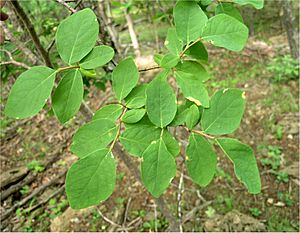Eastern leatherwood facts for kids
Quick facts for kids Eastern leatherwood |
|
|---|---|
 |
|
| Dirca palustris | |
| Scientific classification | |
| Genus: |
Dirca
|
| Species: |
palustris
|
The eastern leatherwood (scientific name: Dirca palustris) is a unique shrub. It can grow up to three meters (about 10 feet) tall. This plant is native to the eastern parts of North America.
You might find it in rich, moist forests. It is not very common in the wild. Sometimes, people even grow it in their gardens. The name "palustris" comes from Latin. It means "of the marsh" or "of the swamps," which tells us where it likes to grow.
It can be tricky to spot the eastern leatherwood. Its small, yellow flowers appear very early in spring. They bloom just before the leaves grow. These flowers also last for only a short time. This plant can look similar to the Spicebush, which is much more common. Spicebush also has small yellow flowers that bloom early.
The eastern leatherwood has a close relative. It is called the Western leatherwood. This plant lives far away on the other side of the continent. You can find it in the San Francisco Bay Area.
Contents
What Makes Eastern Leatherwood Special?
The eastern leatherwood gets its name from its tough, flexible branches. These branches are very strong. They are hard to break, almost like leather. Native Americans once used the bark for various purposes. They made ropes and baskets from it.
Its Unique Appearance
This shrub has smooth, reddish-brown bark. Its leaves are oval-shaped and bright green. In the fall, the leaves turn a lovely yellow color. This makes the plant stand out in the forest.
The small, pale yellow flowers are bell-shaped. They hang down in clusters. These flowers appear before the leaves in early spring. They are an important food source for early pollinators.
Where Does It Grow?
Eastern leatherwood prefers cool, damp places. It often grows in rich, well-drained soils. You can find it near streams or in wooded ravines. It likes areas with some shade. This plant is a good sign of a healthy forest.
Why Is It Uncommon?
Eastern leatherwood is considered uncommon. This is partly because of its specific habitat needs. It also faces challenges from habitat loss. Forests are sometimes cleared for development. This reduces the places where it can grow.
Protecting This Plant
Conservation efforts are important for this plant. Protecting its natural habitats helps it survive. Learning about the eastern leatherwood is a first step. It helps us appreciate its role in our ecosystems.
Images for kids




